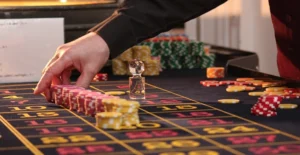When you have three golfers ready for a round, finding the right betting game can make the day much more engaging. Three-player golf betting games offer a unique dynamic, allowing for individual competition or shifting alliances. Whether you prefer point-based challenges, hole-by-hole wagers, or rotating stakes, there’s a format to suit every group. This guide breaks down popular 3-player golf betting games, explaining the rules and offering tips to help you play smarter and enjoy the competition.
Key Takeaways
- Three-player golf betting games add excitement and competition to a round, with formats suited for groups of three.
- Point-based games like ‘Nines’ (5-3-1) and ‘Split Sixes’ award points based on hole scores, creating clear winners on each hole.
- Classic games like the Nassau can be adapted for three players, with separate bets for the front, back, and overall 18 holes.
- Skins games focus on winning individual holes, with carryovers adding risk and reward when scores tie.
- Games like ‘Banker’ create a one-vs-two dynamic, rotating the role of the banker and allowing for individual bets against them.
Why 3-Player Golf Betting Games Are Unique
Playing golf with just two friends can present a unique dynamic compared to larger groups. While many traditional golf betting games are designed for even numbers, threesomes offer their special brand of competition. The absence of a fourth player changes the team structures and can lead to more direct, individual contests. This setup is perfect for those looking for specific golf games for 3 players with stakes that keep everyone engaged hole by hole.
The challenge with threesomes is finding formats that are fair and exciting for all three participants. Unlike foursomes, where you can easily pair up, a threesome often means one player is always on the outside looking in, or the game needs to be structured as a three-way battle. This is where understanding different scoring systems for 3-person golf matches becomes important.
We’ll explore several best golf betting formats for threesomes, covering everything from point-based systems to hole-by-hole wagers. These games are designed to maximize the fun and competition when you’re out on the course with just two buddies.
Understanding Point-Based Formats
When you’ve got three golfers, point-based games are a solid way to keep things interesting. They’re pretty straightforward and can make each hole feel important. Two popular ones are the 5-3-1 game, often called “Niners,” and the general 9-point game concept.
The 5-3-1 (Niners) Game
This game is super easy to grasp, making it a hit for all skill levels. The idea is simple: nine points are up for grabs on every single hole. Here’s how they’re typically handed out:
- Lowest Score: 5 points
- Second Lowest Score: 3 points
- Highest Score: 1 point
So, on any given hole, the player who scores the best gets the most points, and the player who scores the worst gets the fewest. It’s a direct reward for performance on that hole.
Handling Ties in 5-3-1
Ties happen, and in the 5-3-1 game, there’s a clear way to deal with them:
- Two players tie for low score: They split the 5 and 3 points (4 points each), and the third player gets the 1 point.
- Two players tie for high score: The player with the low score gets 5 points, and the two tied players split the 3 and 1 points (2 points each).
- All three players tie: The 9 points are divided equally, so everyone gets 3 points.
It’s a good idea to agree on the value of each point before you start. You can track these points on a scorecard, and at the end of the round, you just tally them up to see who owes what. This format keeps everyone engaged because even if you have a bad hole, you can still pick up points if you don’t finish last.
The 9-Point Game Concept
While “Niners” is a specific way to distribute 9 points, the broader idea of a 9-point game can be adapted. The core principle remains the same: a set number of points is awarded per hole based on individual performance. The 5-3-1 split is just one popular method. Other variations might exist, but the goal is to create a dynamic where every hole contributes to the overall outcome. This type of game is great for keeping the competition lively throughout the entire golf round.
Split Sixes
Split Sixes is a golf game tailor-made for groups of three, offering a dynamic and often intense betting experience. It’s a variation on best-ball, but with a unique point allocation system that keeps everyone engaged on every hole. The core idea is that each hole is worth six points, and these points are distributed based on individual performance relative to the other two players.
How Split Sixes Works
At the start of the round, players agree on the value of each point. On each hole, the player with the lowest score earns four points. The player with the second-lowest score gets two points, and the player with the highest score receives zero points. This simple structure means that consistently scoring well is key to accumulating points.
Handling Ties
Ties are handled in a way that keeps the points flowing:
- Two players tie for low score: They split all six points, meaning each gets three points. The high scorer still gets zero.
- Two players tie for high score: They each get one point, and the low scorer takes the remaining four points.
- All three players tie: Each player receives two points.
The Financial Outcome
Because only one player can win the most points on a given hole, Split Sixes often results in one player having a significant financial advantage by the end of the round. This game is known for putting pressure on players to perform, as only one person is guaranteed to finish the round with a net profit. The payouts are calculated based on the total points accumulated, with the winner taking money from both other players.
Why Play Split Sixes?
This game is great for three players because it’s easy to track and creates a lot of back-and-forth action. It’s a good choice if your group enjoys a bit of risk and wants a game where every single hole matters. It’s a straightforward way to add some friendly competition to your round.
Classic Nassau Adapted for Three Players
The Nassau is a classic golf betting game that works surprisingly well for three players, offering multiple ways to wager throughout the round. It’s a format that keeps everyone engaged because you’re essentially playing three separate matches simultaneously: one for the front nine, one for the back nine, and one for the total 18 holes.
Setting Up the Nassau
Before you even step onto the first tee, you and your playing partners need to agree on the stakes for each of the three segments. This could be a set dollar amount per hole, or a larger sum for winning each nine or the entire match. For instance, you might agree on $5 per hole for the front nine, $5 per hole for the back nine, and $10 for the overall 18-hole score.
The Three Bets
- Front Nine: This is a straightforward match-play competition for the first nine holes. Whoever wins the most holes on the front nine wins this portion of the bet.
- Back Nine: Similar to the front nine, this is another match-play competition, but it covers holes 10 through 18.
- 18-Hole Total: This bet is based on the cumulative score for the entire round. The player with the lowest total score for all 18 holes wins this bet.
Introducing Presses
To add another layer of excitement and strategy, the Nassau game often includes the option for “presses.” A press is essentially a side bet that a player can initiate if they are losing in one of the three segments. If you’re down by a certain number of holes on the front nine, for example, you can declare a press. This doubles the original bet for that segment, starting a new, separate match. If you were down $10 on the front nine and you press, you’re now playing for an additional $10. If you win the press, you break even on the front nine. It’s a way to try and claw back losses or increase your winnings, and it can spice things up, especially if someone is having a rough start. You can learn more about the Nassau golf betting game and its variations.
The beauty of Nassau is its flexibility. You can adjust the stakes, the number of holes for each segment, and the conditions under which a press can be called. This adaptability makes it a go-to game for many groups.
Tracking the Bets
Keeping track of the three separate bets and any presses can get a little complicated, so it’s a good idea to have a simple system. A scorecard with columns for each bet (Front 9, Back 9, Total) and a space to note any presses can be very helpful. This way, everyone can see where they stand at any point in the round.
Skins Games
The Basics of Skins
Skins, also known as ‘cuts,’ is a straightforward yet exciting golf betting game where the goal is to win individual holes outright. Each hole has a predetermined monetary value, and only the player who achieves the lowest score on that hole without any ties claims the prize. If two or more players tie for the lowest score on a hole, that skin ‘carries over,’ meaning the money for that hole is added to the prize for the next hole. This rollover effect can lead to some substantial pots as the round progresses.
Playing Gross vs. Net Skins
When setting up a skins game, you’ll need to decide whether to play for gross or net skins. Gross skins are based on the actual number of strokes taken on a hole, giving an advantage to players with lower handicaps. Net skins, on the other hand, incorporate handicaps, leveling the playing field and allowing players of all skill levels to compete more directly. The choice between gross and net often depends on the mix of players in your group and what you feel will create the most balanced and engaging competition.
Managing Carryovers and Payouts
Carryovers are what make skins so dynamic. Imagine a par-5 where everyone makes par – that pot just got bigger for the next hole. It’s a simple concept, but it adds a layer of anticipation to every single hole. You can decide to pay out skins after each hole, or more commonly, collect the money and pay out at the end of the round. This latter approach often leads to a more dramatic reveal of who the big winners are. For a three-player game, you might set a value of $5 per skin, with carryovers doubling the value for the next hole. So, if the first hole is tied, the second hole is now worth $10 for whoever wins it outright.
Example Payout Structure
Let’s say you’re playing a skins game with a $5 bet per hole, and you have three players: Alice, Bob, and Carol.
- Hole 1: Alice (4), Bob (4), Carol (5). Alice and Bob tie. No skin winner. Carryover.
- Hole 2: Alice (3), Bob (4), Carol (5). Alice wins the hole. Alice wins the $5 from Hole 1 plus the $5 from Hole 2, totaling $10.
- Hole 3: Alice (5), Bob (4), Carol (4). Bob and Carol tie. No skin winner. Carryover.
- Hole 4: Alice (4), Bob (3), Carol (5). Bob wins the hole. Bob wins the $10 from Hole 3 plus the $5 from Hole 4, totaling $15.
This simple structure keeps track of who wins what, and it’s easy to see how quickly the stakes can rise. It’s a great way to add some excitement to your golf betting.
The beauty of skins lies in their simplicity and the potential for dramatic swings. A player can be having a rough day, but one or two well-timed wins on holes with significant carryovers can turn their entire round around. It rewards consistency but also offers a chance for a comeback hero.
Defender and Split Sixes
Split Sixes is a fantastic game for three players, and it keeps everyone engaged because of how the points are handed out. It’s a bit like a best-ball format, but everyone is playing against everyone else, individually. The main idea is to score better than the other two guys on any given hole.
How Split Sixes Works
Each hole is worth six points in total. Here’s how those points get split up based on scores:
- Low Score: Gets 4 points.
- Middle Score: Gets 2 points.
- High Score: Gets 0 points.
So, if you get the best score on a hole, you snag 4 points. If you’re in the middle, you get 2 points, and if you have the worst score, you get nothing for that hole. It’s pretty straightforward, but it adds a layer of pressure because you’re always trying to beat at least one other person.
Handling Ties
Things get a little more interesting when scores are tied:
- Two-Way Tie for Low Score: The two players split the 6 points (3 points each). The third player gets 0.
- Two-Way Tie for High Score: The two players split the 1 point each. The low scorer gets the remaining 4 points.
- Three-Way Tie: All three players get 2 points each.
This point system means that even if you don’t win a hole outright, you can still pick up points by avoiding the last-place finish. It makes every hole matter, and you can’t just coast.
The Defender Variation
Some groups like to add a twist called the ‘Defender’ to Split Sixes. In this version, one player is designated as the ‘Defender’ for a set number of holes, maybe three or six. The Defender plays against the other two players as a team. If the Defender wins the hole, they get all six points. If the team of two wins the hole, they split the points (3 points each). If it’s a tie, everyone gets 2 points. This adds a whole new dynamic, as the Defender has to play exceptionally well to beat both opponents, and the other two players have to work together to take down the Defender. It’s a great way to keep the competition fierce and make sure everyone has a chance to be in the thick of it.
Heads-Tails: Coin-Flip Drama in Three-Player Bets
The Heads-Tails Game
This game is a bit like a coin flip, but with golf. It’s pretty simple to understand, which is why it’s a good choice if you want something straightforward. Basically, on each hole, you’re betting on who will win that specific hole. The twist is how the betting happens.
Here’s how it generally works:
- Hole Winner: The player with the lowest score on a hole wins that hole’s bet.
- The Bet: Before you tee off on each hole, you decide on a bet amount. This could be a set dollar amount, or you could use a point system.
- The Flip: After everyone has played the hole, you determine the winner. If there’s a tie for the lowest score, the hole’s bet carries over to the next hole, kind of like a Skins game.
The real drama comes in how the bets are structured and who gets to set them.
Banker Game
The Banker game offers a unique dynamic for three players, essentially pitting one golfer against the other two in a rotating fashion. This setup creates interesting strategic decisions and can lead to significant swings in who owes whom.
How it Works
- Designate the Banker: For the first hole, one player is chosen as the ‘Banker.’ This role typically rotates to the player who wins the previous hole, often determined by the lowest score. Ties can be broken by the longest putt made on the hole.
- Individual Bets: The Banker plays against each of the other two players individually. Before teeing off on each hole, the non-banker players decide how much they want to wager against the Banker for that specific hole. For instance, Player A might bet $5 against the Banker, while Player B bets $10.
- No Player-vs-Player: Importantly, the two non-banker players are not betting against each other. Their wagers are solely directed at the Banker.
- Winning the Banker Role: The player who achieves the lowest score on a hole becomes the Banker for the next hole.
Adding Layers: Presses
To increase the stakes, players can ‘press’ their bets. This usually happens before the Banker tees off. If a player feels confident, they can double their wager for that hole. The Banker then has the option to ‘press back,’ meaning they can double their wager against all players who pressed them. This can escalate quickly, adding a layer of risk and reward.
This game requires clear communication about bets and presses to avoid confusion. It’s a good idea to have a designated scorekeeper who tracks who is the Banker and the amounts wagered on each hole.
Example Scenario
Let’s say Player 1 is the Banker on Hole 3. Player 2 bets $5 against Player 1, and Player 3 bets $10 against Player 1. If Player 2 shoots a 4 and Player 3 shoots a 5, and Player 1 shoots a 6, then Player 2 wins $5 from Player 1, and Player 3 wins $10 from Player 1. Player 1, having the highest score, loses both bets. For Hole 4, the player with the lowest score on Hole 3 (either Player 2 or Player 3, depending on their scores) becomes the new Banker. This format is a fun way to keep everyone engaged, as anyone can become the Banker and potentially win or lose significant amounts. It’s a good way to add some excitement to your golf betting games.
Recording Scores

Keeping track of scores and money in a three-player golf betting game is pretty straightforward once you get the hang of it. You don’t want to be fumbling around with a crumpled scorecard or trying to remember who owes what after the 18th hole. A little organization goes a long way.
The Basics of Scorekeeping
At its core, you’ll need to record each player’s gross score for every hole. This is the foundation for most betting games. Beyond that, depending on the game, you might also be tracking points, skins, or specific match outcomes (like winning the front nine, back nine, or overall match in a Nassau).
Using a Scorecard Effectively
Most standard golf scorecards will suffice, but you might want to add a column or two for your specific game. For instance, in a 5-3-1 game, you’d want a column to tally the points each player earns per hole. If you’re playing Skins, you’ll need to note which player won each skin and if it carried over.
Here’s a simple way to structure it for a point-based game:
| Hole | Player A Score | Player B Score | Player C Score | Player A Pts | Player B Pts | Player C Pts |
| 1 | 5 | 4 | 6 | 2 | 4 | 0 |
| 2 | 4 | 4 | 5 | 3 | 3 | 1 |
Managing the Money
This is where things can get a bit more complex, especially with games like Split Sixes or Banker. It’s best to have a designated scorekeeper or agree on a system before you tee off. Some groups use a simple ledger or even a dedicated app.
- Point-Based Games: Calculate the total points for each player. Then, multiply their total points by the agreed-upon value per point. The player with the most points wins the most money, and the player with the fewest points pays out.
- Skins Games: Track which player won each skin. If a skin carries over, note that. At the end, multiply the value of each skin by the number of skins a player won. Players who didn’t win any skins pay out to those who did.
- Nassau: Keep track of who wins the front nine, the back nine, and the overall match. Each of these can have a separate bet.
A good rule of thumb is to settle up immediately after the round. This avoids any confusion or awkwardness later on. If you’re playing for significant stakes, consider having one person manage all the payouts to ensure fairness.
Handling Ties and Carryovers
Most games have rules for ties. In point-based games, ties usually mean the points for that hole are split. In Skins, a tie means the skin carries over to the next hole, increasing its value. Make sure everyone understands these rules before starting. A simple note on the scorecard for carryovers can be very helpful.
Applying Handicaps and Presses
When playing golf with friends, especially in a betting format, handicaps and presses are your best friends for keeping things fair and exciting. Handicaps are pretty straightforward; they essentially give strokes to less skilled players to even out the playing field. This means a player with a higher handicap might get a stroke on certain holes, making their score count as one less than they shot. It’s a way to make sure everyone has a shot at winning, regardless of their raw skill level.
Integrating Handicaps
When you’re using handicaps in a three-player game, you’ll want to decide how those strokes are applied. Are they given on every hole, or only on specific holes? A common approach is to give strokes on the hardest holes, as determined by the course’s stroke index. For example, if Player A has a 10 handicap and Player B has a 20, Player B might get a stroke on holes 1 through 10. This can be tracked easily on your scorecard.
The Art of the Press
Presses are where things get interesting. A press is essentially a re-bet or a doubling of the stakes, usually initiated when a player is significantly behind. It’s a way to give a trailing player a chance to catch up. Think of it as a do-over for the betting aspect of the game.
Here’s a common way presses work in a three-player game:
- Trigger: A player is down by a certain number of points or holes. This threshold needs to be agreed upon beforehand.
- Initiation: The trailing player can call for a press. If agreed upon by the other players, the stakes for the remaining holes double.
- Multiple Presses: You can allow for multiple presses, but this can quickly escalate the stakes. It’s wise to set a limit on how many times a press can be called.
The key to using handicaps and presses effectively is clear communication and agreement before the round begins. Without established rules, these elements can lead to confusion or disputes. Make sure everyone understands how handicaps are applied and under what conditions a press can be called and accepted.
For instance, in a game where you’re betting $1 per point, if Player C is down by $5 after nine holes, they might call a press. If accepted, the remaining holes are now worth $2 per point. This adds a layer of risk and reward, making players think twice about their strategy. It’s a great way to keep the match competitive until the very last putt. You can find more about different betting strategies on golf betting games.
Handicap Adjustments and Presses
When you combine handicaps with presses, you can create some dynamic scenarios. For example, a player might be receiving strokes on a hole due to their handicap, but if they then call a press, the value of that stroke might also double. This can lead to significant swings in the match. It’s important to keep a clear record of who is pressing and what the new stakes are. A simple way to manage this is to have a designated scorekeeper who tracks all the bets, handicaps, and presses throughout the round.
Winning Tips
Deciding when to push your luck and when to play it safe is a big part of winning in golf betting games. It’s not just about hitting good shots; it’s about making smart choices that pay off.
Knowing When to Press
Presses are your friend when you’re behind. Think of it like doubling down in blackjack. If you’re playing a Nassau and you lose the front nine, you can ‘press’ that bet. This means you start a new, separate bet for the front nine, essentially doubling the stakes. If you win the press, you can break even on that segment. It’s a good way to try and claw back some losses, but be careful – if you lose the press, you’ve just doubled your deficit.
- Use presses when you’re trailing significantly. If you’re down by a lot, a press offers a chance to make up ground quickly.
- Consider your opponent’s game. If your opponent is prone to mistakes or has a shaky finish, a press might be a good gamble.
- Don’t press if you’re already playing poorly. If your game is off, adding more pressure might just lead to bigger losses.
Playing It Safe
Sometimes, the best move is to just hold your ground. If you’re leading comfortably, especially in a game like the 9-Point game where points are awarded per hole, you might want to avoid unnecessary risks. Focus on securing your lead rather than trying to win every single hole.
- Secure your lead. If you’re ahead, play conservatively to avoid giving your opponents an easy way back into the game.
- Avoid risky shots. Don’t try to be a hero with a difficult recovery shot if a safer bogey is good enough.
- Focus on consistency. In point-based games, consistent scoring often wins out over flashy, high-risk plays.
The key is to constantly assess the situation. Look at the score, the remaining holes, and how your opponents are playing. This information will guide your decisions on whether to go for broke or play it smart. It’s a bit like playing Three Card Poker, where knowing when to bet and when to fold is everything.
Example Scenario: Nassau
Let’s say you’re playing a Nassau, $10 per nine and $10 overall. You lose the front nine ($10). You’re down $10. On the back nine, you’re playing well, but your opponent is also playing solidly. You could press the front nine for another $10. If you win that press, you’re now even for the front nine. If you then win the back nine outright, you’ve won $10 for the back and $10 for the overall match, putting you up $20. But if you lose the press, you’re now down $30 ($10 from the original front nine loss, plus another $10 from losing the press, plus the $10 you might lose on the back nine). It’s a calculated risk.
Choosing the Best 3-Player Betting Game for Your Group
Choosing the right golf betting game for your group of three depends on what kind of vibe you’re going for. Are you looking for something straightforward, or do you want a game that keeps everyone on their toes with constant momentum shifts? It’s all about matching the game’s structure to your group’s personality and skill levels.
Considering Group Dynamics and Skill Levels
If your group has a wide range of handicaps, games that incorporate handicaps or have built-in ways to level the playing field are usually best. For instance, a game like “Nines” (also known as 5-3-1) awards points based on finishing order on each hole, which can help balance out score differences. On the other hand, if everyone is pretty evenly matched, you might enjoy something more cutthroat like “Skins,” where only the lowest score on a hole wins anything, and if there’s a tie, the pot carries over. This can get pretty intense, especially when you’re playing with popular golf wagering games for small groups.
Game Complexity and Duration
Some games are simple to grasp from the first tee, while others have a bit more to them. “Split Sixes,” for example, is a game specifically for three players where points are awarded based on who scores best on each hole, but it can get complicated quickly if you’re not paying attention. It’s a variation of best ball, but with a twist. If you’re new to golf betting or just want a quick round, a simple Nassau bet, where you bet on the front nine, back nine, and total 18 holes separately, might be more your speed. You can even add presses to spice it up. For a more unique challenge, consider the “Banker Game,” where one player acts as the banker for each hole, and the others bet against them individually. This rotates based on who has the lowest score on the previous hole. It’s a fun way to keep things interesting, and you can find more about basic betting strategies on sites like three-card poker.
Popular Choices for Three Players
- Nassau: A classic for a reason. Bets on the front, back, and overall 18 holes. Easy to understand and can be adjusted with a press.
- Skins: High risk, high reward. Wins only occur when a player has the lowest score on a hole. Great for competitive groups.
- Split Sixes: Designed for three players, this game awards points based on performance on each hole, creating a dynamic competition.
- Banker Game: One player is the banker, and others bet against them. The banker’s role rotates, adding a strategic element.
Ultimately, the best game is the one that keeps everyone engaged and having fun. Don’t be afraid to try out different formats until you find the perfect fit for your regular foursome or casual outing.
Frequently Asked Questions
What is a three-ball game in golf?
In a three-player golf game, each player competes against the other two individually. Think of it as playing two separate matches at once. If one player gives you a break on a putt or a hole, you still need to finish that same putt or hole against the other player.
How are points usually given out in three-player golf games?
Games like ‘Nines’ or ‘5-3-1’ are great for three players. Points are given out on each hole based on how well each player scores. The player with the lowest score usually gets the most points, the next lowest gets fewer, and the highest score gets the least. It’s a simple way to keep track of who’s doing well.
Can handicaps be used in three-player golf betting games?
Yes, you can use handicaps! Handicaps help level the playing field, so players with different skill levels can compete fairly. The game’s rules will explain how to apply handicaps, often by giving strokes to less experienced players.
What is a Nassau bet in golf?
A ‘Nassau’ bet is a popular choice. It splits the game into three parts: the front nine holes, the back nine holes, and the total 18 holes. This means you can win or lose on each of these parts separately, making the game exciting throughout the round.
How does a Skins game work?
A ‘Skins’ game is all about winning individual holes. If you have the lowest score on a hole, you win that ‘skin.’ If two or more players tie for the lowest score, nobody wins that skin, and the prize money carries over to the next hole. This can lead to big payouts!
What is the Banker game in golf?
The ‘Banker’ game is unique because one player plays against the other two. The banker changes each hole, usually going to the player who had the lowest score on the previous hole. The other players decide how much they want to bet against the banker.
What are ‘presses’ in golf betting games?
Yes, ‘presses’ are a way to add more betting action. If a player is losing a match, they can choose to ‘press,’ which essentially means starting a new, separate bet on the same part of the game (like the front nine). This is often ‘double or nothing,’ adding risk and a chance to catch up.
How should scores and money be tracked during a game?
Keeping track is simple if you agree on a system beforehand. You can use a scorecard, a notebook, or even a golf app. Just make sure everyone knows how points or money are being tallied for each hole and the overall game.
Daniel Chase is a seasoned casino analyst and iGaming writer with over 10 years of experience in the online gambling industry. He specializes in game strategy, casino odds, and player-focused reviews. Daniel is passionate about helping players make smarter decisions through transparency, real data, and honest insight.











